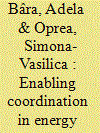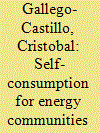|
|
|
Sort Order |
|
|
|
Items / Page
|
|
|
|
|
|
|
| Srl | Item |
| 1 |
ID:
171493


|
|
|
|
|
| Summary/Abstract |
Based on a survey among customers of seven German municipal utilities, we estimate two regression models to identify the most prospective customer segments and their preferences and motivations for participating in peer-to-peer (P2P) electricity trading and develop implications for decision-makers in the energy sector and policy-makers for this currently relatively unknown product. Our results show a large general openness of private households towards P2P electricity trading, which is also the main predictor of respondents' intention to participate. It is mainly influenced by individuals’ environmental attitude, technical interest, and independence aspiration. Respondents with the highest willingness to participate in P2P electricity trading are mainly motivated by the ability to share electricity, and to a lesser extent by economic reasons. They also have stronger preferences for innovative pricing schemes (service bundles, time-of-use tariffs). Differences between individuals can be observed depending on their current ownership (prosumers) or installation probability of a microgeneration unit (consumers, planners). Rather than current prosumers, especially planners willing to install microgeneration in the foreseeable future are considered to be the most promising target group for P2P electricity trading. Finally, our results indicate that P2P electricity trading could be a promising niche option in the German energy transition.
|
|
|
|
|
|
|
|
|
|
|
|
|
|
|
|
| 2 |
ID:
112921


|
|
|
|
|
| Publication |
2012.
|
| Summary/Abstract |
The accumulation and maintenance of emergency oil stocks in accordance with the requirements of the European Union involve changes in legislation, the strengthening of national stockholding institutions and the attraction of investment. Despite these challenges, almost all Southeastern and Eastern European countries have begun to align their oil stockholding arrangements with the European model, albeit there is variation in the actual degree of convergence. The greatest convergence is observed for Croatia and the Former Yugoslav Republic of Macedonia. In marked contrast, the oil stockholding system of Moldova continues to be different from the European model. This study provides an overview of the Southeastern and Eastern European countries' progress in approximating the European requirements for emergency oil stocks and identifies the factors responsible for the cross-country variation. The differences observed stem from the extent to which the countries are legally obliged to comply with the European provisions, their membership aspirations, levels of energy-related investment from the European Union, and dependence on oil imports.
|
|
|
|
|
|
|
|
|
|
|
|
|
|
|
|
| 3 |
ID:
192758


|
|
|
|
|
| Summary/Abstract |
Starting from the EU vision for Energy Communities (EC), our purpose is to support them by proposing a Digital Twin (DT) that includes a bi-level optimization model to deliver coordination, economic, social, and environmental benefits to its members that can be quantified as Key Performance Indicators (KPI). The diversity of EC members from the size and interest perspectives leads us to consider a bi-level optimization model. It offers support to individual consumers/prosumers (first level) and coordination for EC (second level). This model is embedded into a DT that replicates the EC and the operation of individual entities such as consumers/prosumers and public assets. The DT is created as an automatic assistant with two components: iEMS – as a member's assistant and eEMS – as an EC assistant. These components optimize the schedule, generate bids for the Local Electricity Market (LEM) and control the flexible appliances of the participants to deal with deficits and surpluses. The DT receives input from EC members, LEM, metering system and improves the operation of the EC in a two-way continuous exchange data flow. Furthermore, it is a reliable framework to test and improve models, regulations and policies in emergent EC as DT provides alternatives regarding its functionalities: optimization, market operation, setting the clearing price, settlement, value sharing for distributing benefits, etc. It can be extended to support grid operators to design tariffs, testing regulation and offer additional energy services. The proposed DT model is tested within an EC case study, both on a seasonal and an annual basis. The average trading index on LEM is 0.6 during the summer and 0.3 during the winter months, while the Degree of Local Sufficiency (DLS) for the EC is 0.45 in summer and 0.28 in winter. Moreover, the proposed LFM model reduces the exchanges with the main grid by an average of 45 kW in summer, that represents almost 15% of the average exchange at peak hours.
|
|
|
|
|
|
|
|
|
|
|
|
|
|
|
|
| 4 |
ID:
185687


|
|
|
|
|
| Summary/Abstract |
Climate emergency has changed the way of supplying energy, replacing fossil fuels in favour of a transition to renewable sources crucial for the system decarbonization. This change has led to a review of the electricity consumption and distribution model. Recently end-users connected to distribution grids have taken an increasing active role in the electrical power system. Such a situation highlights how the combination between distributed generation-active user, through the concept of energy self-consumption that turns in energy sharing for a ‘collective’ form, allowed by virtual self-consumption, seems to be a good solution to achieve both climate targets and solve technical issues related to renewables penetration. Aggregation of end-users which produce and self-consume their energy within the same geographical perimeter express a new way to use renewable energy represented by the energy communities. The paper identifies the key elements that effect a business model for energy sharing by residential end-users equipped with small-scale renewable generation plants. In addition the simulation analysis investigate the feasibility from the aggregator point of view as well as the individual end-users evaluating also a minimum size for a viable renewable energy community.
|
|
|
|
|
|
|
|
|
|
|
|
|
|
|
|
| 5 |
ID:
092752


|
|
|
|
|
| Publication |
2009.
|
| Summary/Abstract |
Why would countries without a membership perspective seek integration into the EU's internal energy market? One major element of the EU's external energy policy is the export of EU energy norms and regulations to neighbourhood countries and beyond. A core legal instrument the EU uses in this context is the Energy Community Treaty (ECT). The ECT goes both geographically and regarding its depth significantly beyond neighbourhood or association policies, addressing potentially also countries in the 'far neighbourhood' and aiming at the creation of a Single Market for energy with these countries. While, however, EU candidate countries are obliged to adopt the "acquis" before accessing the EU and therefore comply to EU rules already before they enter the Club, I argue that countries with no or only a vague membership perspective - i.e. countries where the EU cannot apply the "conditionality" - approach (e.g., ENP countries)-aim at deeper integration with the EU because they are either eager to demonstrate their capability and potential to become part of the Club, they seek greater independence from a regional hegemon or they envisage significant economic gains as common norms, rules and standards are likely to increase economic exchange with the EU.
|
|
|
|
|
|
|
|
|
|
|
|
|
|
|
|
| 6 |
ID:
132389


|
|
|
|
|
| Publication |
2014.
|
| Summary/Abstract |
The European Commission has spelled out its policy ambition for EU energy cooperation with the southern neighbourhood with plans for the establishment of an 'Energy Community'. Its communications make clear that an Energy Community should be based on regulatory convergence with the EU acquis communautaire, much in the same vein as the existing institution carrying the same name; the Energy Community with Southeast Europe. It is puzzling that the Commission insists on repackaging this enlargement concept in a region with very different types of relationships vis-à-vis the EU, especially when considering the lukewarm position of key stakeholders in the field. According to them, any attempt to introduce a political integration model in this highly sensitive issue area in the politically fragmented MENA region might run the risk of hurting the incremental technical integration process that has slowly emerged over the past few years.
|
|
|
|
|
|
|
|
|
|
|
|
|
|
|
|
| 7 |
ID:
191218


|
|
|
|
|
| Summary/Abstract |
This paper demonstrates how preferences for energy trading are influenced by autarky aspirations and possible financial benefits from energy trading in the form of lower energy expenses and additional income. It presents findings from a survey on preferences for energy trading on a community-based platform within a residential estate setting. The survey included a choice experiment of hypothetical home choices with the possibility of energy trading on a peer-to-peer (P2P) energy trading platform. It also distinguished between preferences for buying and selling. Participants were 649 residents of housing estates in Ibadan, a Nigerian city. According to our logistic regression analysis, willingness to participate in energy trading was influenced by autarky aspirations and financial benefits. The financial benefits that interest respondents include gaining additional income from P2P energy trading and reducing overall power expenses. The autarky benefit that drives interest in P2P is “reduced reliance” on the grid for electricity. Real estate developers could therefore capitalise on consumers' high levels of interest in the benefits of homes with P2P energy trading capabilities. Nigerian energy policymakers should put in place structures that support P2P because P2P energy trading can unlock the additional value of solar PV for residential consumers.
|
|
|
|
|
|
|
|
|
|
|
|
|
|
|
|
| 8 |
ID:
177399


|
|
|
|
|
| Summary/Abstract |
European climate polices acknowledge the role that energy communities can play in the energy transition. Self-consumption installations shared among those living in the same building are a good example of such energy communities. In this work, a regional analysis of optimal self-consumption installations under the new legal framework recently passed in Spain is performed. Results show that the optimal sizing of the installation leads to economic savings for self-consumers in all the territory, for both options with and without remuneration for energy surplus. A sensitivity analysis on technology costs revealed that batteries still require noticeably cost reductions to be cost-effective in a behind the meter self-consumption environment. In addition, solar compensation mechanisms make batteries less attractive in a scenario of low PV costs, since feeding PV surplus into the grid, yet less efficient, becomes more cost-effective. An improvement for the energy surplus remuneration policy in the context of the current legislation was proposed and analysed. It consists in the inclusion of the economic value of the avoided power losses in the remuneration.
|
|
|
|
|
|
|
|
|
|
|
|
|
|
|
|
| 9 |
ID:
192744


|
|
|
|
|
| Summary/Abstract |
Global and national policies are increasingly addressing the reduction of greenhouse gases (GHG) emissions and the diffusion of renewable energy resources. Building efficiency and decarbonisation pathways are often supported by promoting the installation of solar energy sources. Urban solar assessments are hence extremely useful to identify favourable locations and sizing of photovoltaic (PV) installations. This research aims to estimate the solar PV potential for a city-dense context. The case study is the downtown area of Toronto (Canada). While most of previous studies look at only one scale, this work adopts a multi-scalar methodology to model PV potential within the main residential building archetypes within the selected location. Rooftop GIS-based analysis estimates up to 26% satisfied electricity consumption for detached houses, and 7% for apartment buildings through polycrystalline PV. A following optimisation performed with the tool URBANopt shows solar block-scale best configurations and profitable financially ones. PV panels with net-metering achieve from 18% up to 41% self-sufficiency. The two assessments confirm that local solar resources can reduce energy dependency on the grid and promote the feasibility of energy communities. This study demonstrates how energy tools from GIS to block-scale are critical to support local administrations in urban planning and PV plans.
|
|
|
|
|
|
|
|
|
|
|
|
|
|
|
|
|
|
|
|
|